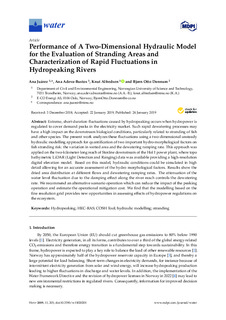| dc.contributor.author | Juarez, Ana | |
| dc.contributor.author | Adeva Bustos, Ana | |
| dc.contributor.author | Alfredsen, Knut | |
| dc.contributor.author | Dønnum, Bjørn Otto | |
| dc.date.accessioned | 2019-04-02T12:33:22Z | |
| dc.date.available | 2019-04-02T12:33:22Z | |
| dc.date.created | 2019-01-24T13:20:05Z | |
| dc.date.issued | 2019 | |
| dc.identifier.citation | Water. 2019, 11 . | nb_NO |
| dc.identifier.issn | 2073-4441 | |
| dc.identifier.uri | http://hdl.handle.net/11250/2592954 | |
| dc.description.abstract | Extreme, short-duration fluctuations caused by hydropeaking occurs when hydropower is regulated to cover demand peaks in the electricity market. Such rapid dewatering processes may have a high impact on the downstream biological conditions, particularly related to stranding of fish and other species. The present work analyzes these fluctuations using a two-dimensional unsteady hydraulic modelling approach for quantification of two important hydro-morphological factors on fish stranding risk: the variation in wetted area and the dewatering ramping rate. This approach was applied on the two-kilometer-long reach of Storåne downstream of the Hol 1 power plant, where topo bathymetric LiDAR (Light Detection and Ranging) data was available providing a high-resolution digital elevation model. Based on this model, hydraulic conditions could be simulated in high detail allowing for an accurate assessment of the hydro morphological factors. Results show the dried area distribution at different flows and dewatering ramping rates. The attenuation of the water level fluctuation due to the damping effect along the river reach controls the dewatering rate. We recommend an alternative scenario operation which can reduce the impact of the peaking operation and estimate the operational mitigation cost. We find that the modelling based on the fine resolution grid provides new opportunities in assessing effects of hydropower regulations on the ecosystem. | nb_NO |
| dc.language.iso | eng | nb_NO |
| dc.publisher | MDPI | nb_NO |
| dc.rights | Navngivelse 4.0 Internasjonal | * |
| dc.rights.uri | http://creativecommons.org/licenses/by/4.0/deed.no | * |
| dc.title | Performance of A Two-Dimensional Hydraulic Model for the Evaluation of Stranding Areas and Characterization of Rapid Fluctuations in Hydropeaking Rivers | nb_NO |
| dc.type | Journal article | nb_NO |
| dc.type | Peer reviewed | nb_NO |
| dc.description.version | publishedVersion | nb_NO |
| dc.source.pagenumber | 26 | nb_NO |
| dc.source.volume | 11 | nb_NO |
| dc.source.journal | Water | nb_NO |
| dc.identifier.doi | 10.3390/w11020201 | |
| dc.identifier.cristin | 1664456 | |
| dc.description.localcode | © 2019 by the authors. Licensee MDPI, Basel, Switzerland. This article is an open access article distributed under the terms and conditions of the Creative Commons Attribution (CC BY) license (http://creativecommons.org/licenses/by/4.0/). | nb_NO |
| cristin.unitcode | 194,64,91,0 | |
| cristin.unitname | Institutt for bygg- og miljøteknikk | |
| cristin.ispublished | true | |
| cristin.fulltext | original | |
| cristin.qualitycode | 1 | |

